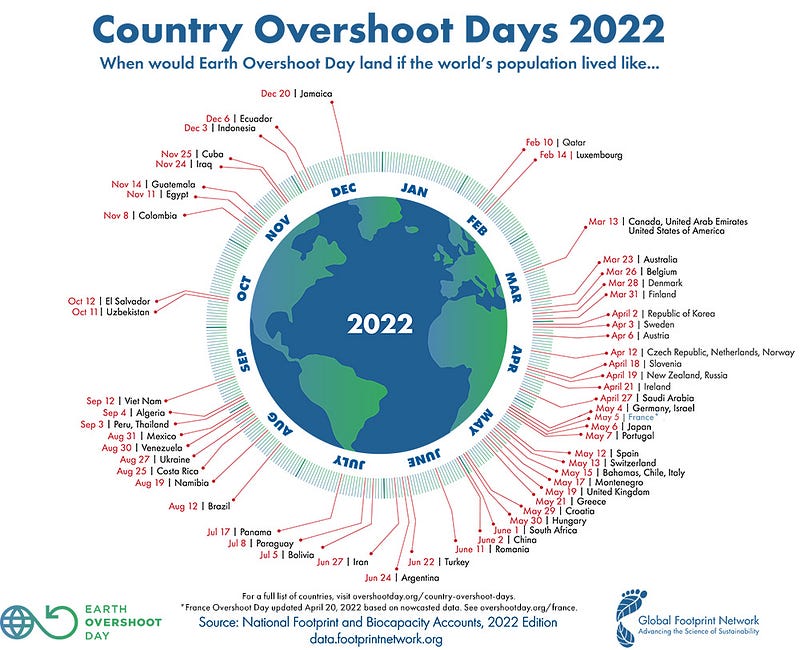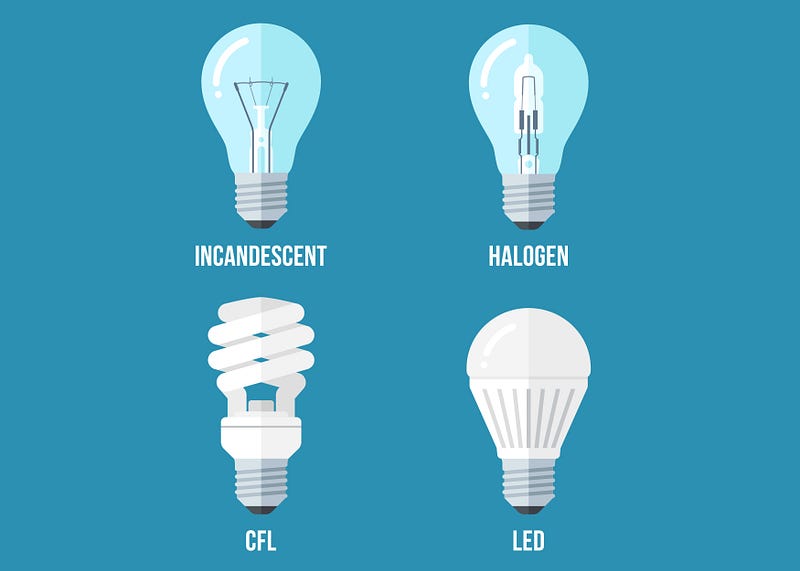# Effective Strategies for Energy Efficiency to Save Our Planet
Written on
Chapter 1: The Urgency of Energy Efficiency
Our planet faces severe challenges, evident from the increasing frequency of natural disasters like wildfires, devastating floods, and extreme heatwaves. These events serve as a stark reminder that immediate action is essential to protect the environment we cherish. The alarming rate of species extinction further emphasizes the need for urgent measures.
One contributing factor to our environmental crisis is the excessive consumption of natural resources, which outpaces the Earth’s ability to replenish them. In 2022, Earth Overshoot Day occurred on July 28, indicating that we had already consumed the planet’s available resources for that year by mid-year. The following graphic illustrates when various countries reached their overshoot day in 2022:

This unsustainable usage of resources will take over a millennium to recover from and has led to several critical tipping points. One such point is the unavoidable rise in global temperatures, which has surpassed 1.5 degrees Celsius, largely due to rising levels of CO2 and other greenhouse gases. Since the industrial revolution, CO2 levels have surged by 48%, reaching heights not seen in 800,000 years.
Fortunately, we have the power to alter this downward trajectory through significant and coordinated efforts. A primary avenue for this change is through enhancing energy efficiency. By minimizing energy waste, we can make a substantial impact, as every aspect of our lives—from heating and electricity in our homes to transportation and production processes—relies on energy consumption.
Section 1.1: Energy Efficiency in Urban Settings
To begin with, enhancing energy efficiency in urban environments is vital. There are numerous practical strategies to achieve this:
- Adopting Circular Systems: Cities currently operate on linear systems where products are used and discarded. Transitioning to a circular economy—where products are shared, reused, repaired, and recycled—can significantly improve energy efficiency.
- Promoting Walkability and Cycling: Urban design can encourage walking and biking by situating work and recreational activities close together, transforming these modes of transport into the preferred options.
- Building Upward: Constructing taller buildings that integrate workspaces, residences, shopping, and leisure activities can create denser urban areas, reducing the need for extensive travel. A notable example of this innovative design is The Line in Saudi Arabia, a 170 km linear city structured in three levels:
- Offering Shared Services: Implementing district-wide heating and cooling systems and providing shared resources not only improves energy efficiency but also reduces space requirements and costs. Makerspaces can also foster community collaboration and resource sharing.
- Encouraging Local Work Opportunities: Integrating workplaces into neighborhoods supports local economies and enhances community pride. Initiatives like repair cafes and urban gardens contribute to reducing waste and improving overall well-being.
Further reading: How Urban Gardening Contributes to Sustainable Development Goals
Section 1.2: Enhancing Building Energy Efficiency
Next, improving energy efficiency in buildings, both new and existing, is crucial. Here are some effective measures:
- Constructing High-Performance Buildings: New constructions can be designed to use significantly less energy—up to 20% of what traditional buildings consume.
- Retrofitting Older Structures: Enhancing older buildings with better insulation, renewable energy sources, and space for urban agriculture can improve their energy efficiency and self-sufficiency.
- Upgrading Insulation: Effective insulation minimizes energy needs for heating and cooling, making homes more comfortable and efficient.
- Utilizing Heat Pumps: Devices like heat pumps can transfer heat more efficiently than traditional systems, using a fraction of the energy.
- Switching to LED Lighting: Replacing conventional bulbs with LED lights can lead to an 80% reduction in energy consumption, primarily because they emit less heat.

Further readings: Improving Efficiency of Buildings through Digitalization
Section 1.3: Transforming Transportation
The final component of enhancing energy efficiency lies in optimizing transportation methods. Beyond making cities more pedestrian- and bike-friendly, consider these strategies:
- Promoting Public Transit: As public transportation is generally more energy-efficient than individual car use, offering low-cost or free transit options can encourage more people to utilize these services.
- Embracing Electric and Hydrogen Vehicles: Electric vehicles use only 20% of the energy needed by petrol cars, while hydrogen vehicles require 50% less. Transitioning to these alternatives can significantly lower energy consumption.
- Limiting Energy Luxuries: Reducing activities with high energy costs, such as air travel and the import of luxury goods, can lead to substantial energy savings.
Further readings: Electric, Hydrogen, Or Biofuel Cars: Which Will Help Save Our Planet?
Conclusion: Taking Action for a Sustainable Future
In summary, we can contribute to saving our planet by enhancing energy efficiency in cities, buildings, and transportation. Cities can implement circular systems, create walkable environments, and support local initiatives. New constructions can be designed for high performance, while older buildings can be retrofitted for efficiency. Moreover, promoting public transport and adopting cleaner vehicle technologies are essential steps toward a sustainable future.
Here are some actionable suggestions for you and me to enhance our energy efficiency:
- Walk or bike to work.
- Utilize public transport whenever possible.
- Rent or borrow instead of buying new items.
- Choose a residence close to your workplace.
- Upgrade to LED lighting.
- Replace conventional heating systems with heat pumps.
- Insulate your home for better energy conservation.
- Opt for electric or hydrogen cars over petrol vehicles.
- Offset carbon emissions from luxury activities.
For more ideas on reducing energy consumption at home, refer to “How To Reduce The Impact Of Increasing Energy Prices.”
Do you have any additional suggestions? Please share your thoughts in the comments to inspire others.
Related articles: It’s Getting Hot: 19 Strategies That Can Help Our Planet To Cool Down
This article draws from:
Barnard, P., Moomaw, W. R., Fioramonti, L., Laurance, W. F., Mahmoud, M. I., O’Sullivan, J., … & Ziervogel, G. (2021). World scientists’ warnings into action, local to global. Science Progress, 104(4), 00368504211056290.
The first video title is Conserve energy to save money AND save the planet - YouTube. This video discusses various strategies for conserving energy, which not only helps save money but also contributes positively to the environment.
The second video title is EASY WAYS TO CONSERVE ENERGY (how to save money by living zero waste) - YouTube. This video presents simple and effective energy conservation tips that align with a zero-waste lifestyle.